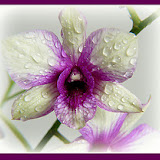
orchid popular name for members of the Orchidaceae, a family of perennial herbs widely distributed in both hemispheres. The unusually large family (of some 450 genera and an estimated 10,000 to 17,500 species) includes terrestrial, epiphytic (see epiphyte ), and saprophytic (subsisting on decomposing material) genera. Although the latter may sometimes lack chlorophyll, none is actually parasitic. Orchids grow most abundantly in tropical and subtropical forests, where they are largely epiphytic; the temperate genera thrive in all kinds of shaded habitats except excessively dry or cold ones. Most temperate orchids and all those of
A Highly Varied Plant Family
This family of monocotyledonous plants has evolved from prototypes of the lily and amaryllis family and is noteworthy for the wide variety of its highly specialized and curiously modified forms. Epiphytic types have a stem swollen at the base to form a pseudobulb (for food storage) and pendulous aerial roots adapted for water absorption and sometimes containing chlorophyll to make photosynthesis possible. In terrestrial types a symbiotic relationship often exists between the roots and filamentous fungi (mycorrhiza). Horticulturists have found that the presence of certain fungi is necessary for the germination of the minute seeds. Orchid pollen occurs as mealy or waxen lumps of tiny pollen grains, highly varied in form.
The flowers characteristically consist of three petals and three petallike sepals, the central sepal modified into a conspicuous lip (labellum) specialized to secrete nectar that attracts insects. Most of the diverse forms of orchid flowers are apparently complicated adaptations for pollination by specific insects, e.g., the enormous waxflower of
Orchid Species
The expensive orchid of the florists' trade is usually the large cattleya; species of this genus ( Cattleya ) are epiphytic plants native to tropical
About 140 species of orchid are native to North America, usually as bog plants or flowers of moist woodlands and meadows. Species of lady's-slipper, or moccasin flower ( Cypripedium ) [Lat.,=slipper of Venus], include the pink-blossomed common, or stemless, lady's-slipper ( C. acaule ) and the showy lady's-slipper ( C. reginae ), both of the Northeast, and varieties of the yellow lady's-slipper ( C. calceolus ), which grow in all but the warmest regions of the continent. Other terrestrial genera that grow as American wildflowers are the fringe orchids ( Blephariglottis ); the small-blossomed twayblades (species of Liparis and Listera ); the pogonias, or beard-flowers (Pogonia ); the wild pinks, or swamp rose orchids ( Arethusa ), of northeastern sphagnum bogs; the grass pinks ( Limodorum ) of eastern bogs and meadows; and the ladies'-tresses, or pearl-twists ( Spiranthes ), with a distinctive spiral arrangement of yellowish or white flowers. The coral-roots (Corallorhiza ), named for the corallike branching of their underground rhizomes, are a nongreen saprophytic genus which includes some North American species. Because orchids are characteristically slow growing and difficult to seed, excessive picking and futile attempts to transplant have depleted native species in some areas.
Economic Uses
Orchids are among the most highly prized of ornamental plants. In
Classification
The orchid family is classified in the division Magnoliophyta , class Liliopsida, order Orchidales.
Bibliography
See R. T. Northen, Home Orchid Growing (3d ed. 1970); M. A. Reinikka, A History of the Orchid (1972).


